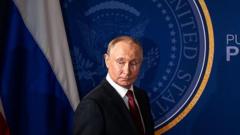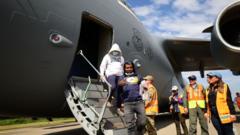With advances in hypersonic capabilities, nations grapple with a new landscape of military deterrence and defense.
The Hypersonic Arms Race: Who Leads the Pack?

The Hypersonic Arms Race: Who Leads the Pack?
The escalating competition in hypersonic missile technology among global powers poses a strategic challenge.
In a striking display last October, Beijing showcased its hypersonic missile arsenal—specifically the Dongfeng DF-17—on the National Day parade, highlighting China's advancement in military technology. The hypersonic DF-17, measuring 11 meters and weighing 15 tons, travels at speeds exceeding five times the speed of sound. This technology has raised concerns about shifts in warfare dynamics, making hypersonic missiles a focal point of contemporary global tensions, particularly among China, Russia, and the U.S.
William Freer, a national security fellow at the Council on Geostrategy, points out that the rapid development of these weapons represents a new era of geopolitical competition reminiscent of the Cold War. While China currently leads the hypersonic arms race, followed closely by Russia, the U.S. continues to invest heavily in catching up, although the UK has yet to develop its own hypersonic systems.
China's investment in hypersonic technology has paid off, allowing them to surpass Western nations who, for years, previously concentrated on counter-terrorism operations rather than preparing for potential state-to-state conflicts. As noted by former British intelligence chief Sir Alex Younger, the rise of China's military might caught many nations off guard.
Other players in the hypersonic domain include North Korea and Iran, both claiming to develop more advanced missile systems. The speed and unpredictability of hypersonic missiles pose significant challenges for defense systems, as they make timely detection and interception considerably difficult.
The current fastest operational hypersonic missile is Russia's Avangard, boasting claimed speeds of up to Mach 27. In contrast, the U.S. is developing its "Dark Eagle," aiming to strengthen its defensive posture amid this evolving threat landscape.
Experts emphasize that the real shift brought by hypersonics isn't merely the speed but the complexities involved in detection and defense. Current military strategies may need to adapt rapidly due to the reduced response time presented by these state-of-the-art weapons.
Significantly, the competition is not without its controversies. Observers urge caution regarding claims from nations like Russia, which have, at times, exaggerated their technological achievements.
With both sides working to improve their capabilities, military analysts caution that hypersonics have not revolutionized warfare; rather, they have compressed the time frames in which nations strategize. Ultimately, as seen in various global flashpoints, the growing hypersonic arsenal will likely lead to a reevaluation of military strategies and international relations.



















